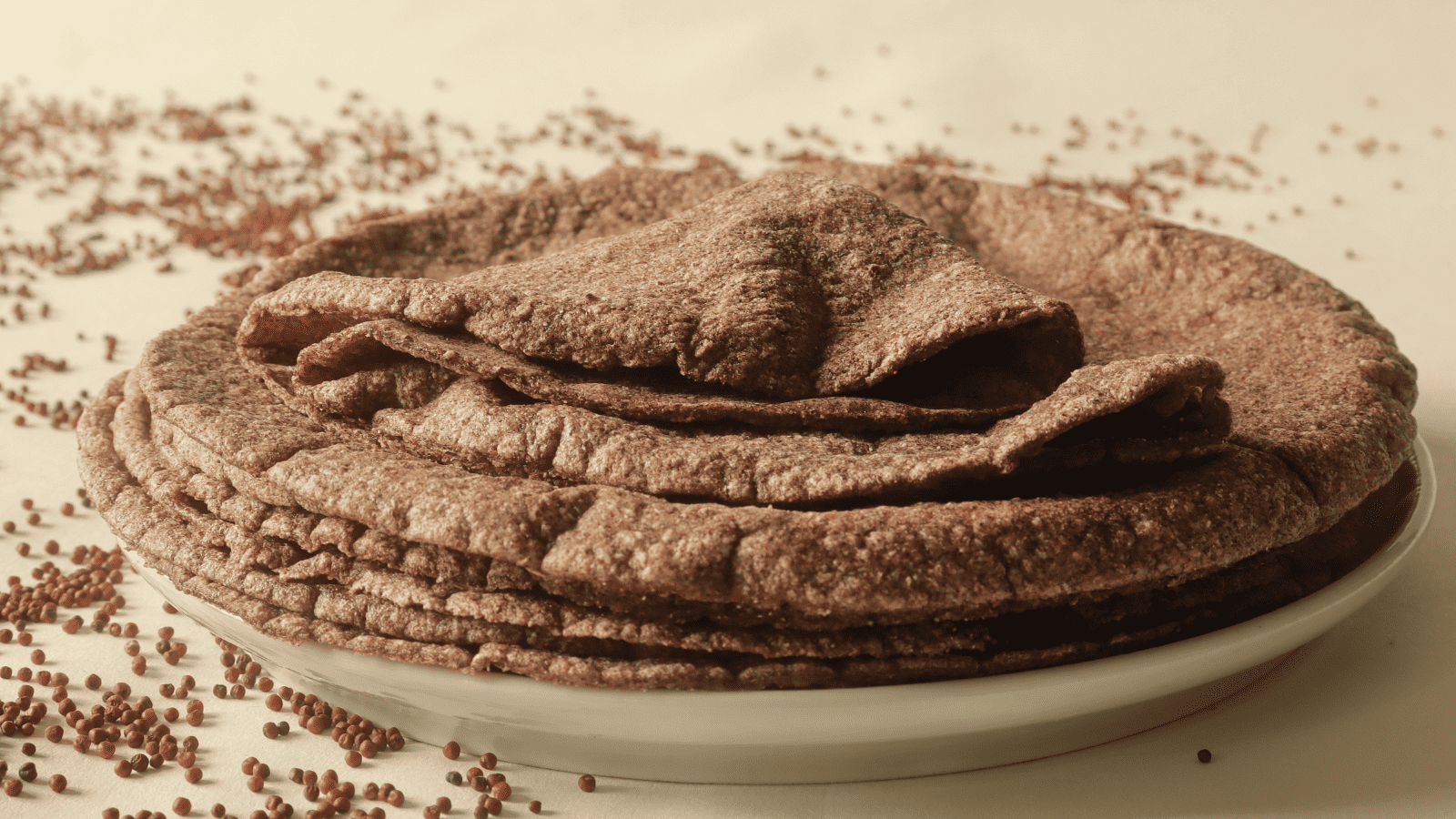Ragi Gluten Free Gur Pare Recipe: A Tasty, Healthy Indian Twist
Have you ever wondered about the origins of that delicious ragi gluten free gur pare you savored last Diwali? Well, you’re in for a treat! This hearty recipe has roots steeped in tradition and cultural significance, and it’s also riding the wave of rising popularity for gluten-free dishes.
The unique taste profile of this ragi cake recipe is something you don’t want to miss out on. So why not dive into the world of ragi recipes and discover how this humble grain is transforming everyday cooking? You’ll find value in every bite!

Ingredients for Crafting Ragi Gluten Free Gur Pare
Essential Components
Let’s dive straight into the heart of our ragi-gluten-free-gur-pare recipe. The leading players in this culinary game are:
- Ragi flour
- Jaggery (gur)
- Ghee
- Water
These four amigos will make your taste buds dance with joy!
Quality Matters, Folks!
Like a good book needs quality words, a great recipe craves top-notch ingredients. Your ragi flour should be gluten-free and sourced from reliable places. Remember, good stuff in equals good stuff out!
Sourcing Gluten-Free Ragi Flour
Not all flours are created equal! You’ll need to hunt down some gluten-free ragi flour. It might not be chilling next to the wheat flour at your local grocery store, but trust me; it’s worth the scavenger hunt.
Get Those Proportions Right!
Now let’s talk about balance. You don’t want to overpower the delicate flavor of your gur-pare with too much ghee or drown it in water. Here’s a quick rundown on how to keep things even-steven:
- Take two cups of ragi flour.
- Add one cup of jaggery (gur).
- Mix in half a cup of ghee.
- Slowly add water while you knead until you get a firm dough.
Break off small pieces and roll them out flat before frying them up golden brown.
That’s it! You’re now a master chef crafting delicious ragi-gluten-free-gur-pare!
Detailed Guide to Preparing Gluten-Free Gur Pare
Dough Prep and Cooking
- Mix ragi flour, gur, and butter into a dough. Add grated carrots for extra flavor. Tricky part? Handling ragi dough due to lack of gluten. It’s like trying to catch a slippery fish! But don’t worry, keep it cool and it’ll behave.
- Roll the dough using parchment paper – your new best friend in the kitchen.
- Cut into diamond shapes (like shakarparas), or use cookie cutters if you feel fancy.
Baking/Frying
- Got an air fryer? Great! Set it at 180°C, and bake for 12-15 minutes.
- More of an oven person? No problemo! Set your oven to 180°C on a baking tray lined with parchment.
- Love traditional methods? Deep fry these babies until golden brown.
Perfect Texture Tips
- Keep an eye on them while cooking – in too little time, they’ll be soft as cake; too long, and you might end up with burnt crisps!
- Ideal texture – crunchy outside, slightly soft inside (think carrot cake in a loaf pan).
Storing Leftovers
Got leftovers? Here are some tips:
- Cool completely before storing (no one likes soggy gur pare).
- Use an airtight container – it keeps them fresh and crunchy.
- Store at room temperature – sweet potatoes last longer outside the fridge, so do these!
Remember, folks, this isn’t rocket science, but baking is all about precision, like measuring your ingredients right down to the top and setting your timer accurately. So get out that spatula and start experimenting with this ragi-gluten-free-gur-pare recipe today!
Adding Flavor: Additional Ingredients for Ragi Dish
Spices to Enhance Taste
Let’s dive right into the first tip – spices. Sprinkle cardamom or nutmeg powder into your ragi-gluten-free-gur-pare recipe. It’s like a magic potion that instantly uplifts the taste.
Crunchy Add-ons
Who doesn’t love a bit of crunchiness in their snacks? Toss some nuts or seeds into the dough mixture. Just ensure they are finely chopped so as not to overpower the dish.
Sweetness Adjustments
Too sweet, too bland? Fix it with natural sweeteners. Honey, stevia, or even jaggery can do wonders. Remember, it’s all about getting that perfect balance.
Experiment with Flavors
Now comes the fun part – experimenting! Add yogurt, ghee, baking powder, or ripe bananas to your large bowl. Or how about sprinkling chocolate chips on top before baking?
Just remember these points while mixing:
- Start by adding milk gradually to avoid lumps.
- Mix well until you get a smooth consistency.
- Don’t forget to grease the sides of your baking tray with ghee.
- Sprinkle toppings like brown sugar or chocolate chips evenly over the dough before popping it into the oven.
So go ahead and give these tips a shot next time you’re making this dish! After all, who said authentic dishes can’t have a twist?
Health Benefits of Ragi in Gluten-Free Recipes
Ragi, a powerhouse of nutrition, is a critical ingredient in the ragi-gluten-free-gur-pare recipe. It’s not just about dodging empty calories but also packing severe health perks.
Fiber-Rich Food
Ragi is high in fiber. It aids digestion and helps manage weight effectively. No more bloating or constipation issues, thanks to this grain.
- It helps you feel full for longer
- Prevents overeating
- Promotes healthy gut bacteria
Calcium Treasure Trove
Think calcium, think ragi! This grain promotes bone health like no other. It’s an easy way to keep those osteoporosis worries at bay.
- Strengthens bones
- Supports teeth health
- Essential for growing kids and aging adults
Antioxidant Powerhouse
Antioxidants? Check! Ragi reduces inflammation and slows down aging effects.
- Fights free radicals
- Boosts skin health
- Enhances overall immunity
Diabetic-Friendly Grain
With its low glycemic index, ragi is suitable for people with diabetes too!
- Controls blood sugar levels
- Reduces risk of heart disease
- Manages diabetes symptoms
All these benefits without piling up calories! Now that’s what we call a superfood. So next time you’re cooking up a storm, don’t forget to add some ragi to your gluten-free recipe.
Mastering the Process: Making Ragi-Based Dishes Gluten-Free
Adapting Traditional Recipes
Adapting traditional recipes to cater to gluten intolerances/allergies is no rocket science. Swap wheat, whole wheat flour, and other gluten-containing grains with gluten-free alternatives like finger millet (ragi), rice, oats, or quick oats. For instance:
- Wheat chapatis -> Finger millet rotis
- Whole wheat cakes -> Oats-based baking goodies
Techniques for Dough Stability
Gluten gives dough its elasticity; without it, your dough might crumble. Here’s how you can avoid that:
- Use a mix of flours. Combining ragi with other gluten-free flours like rice or oat flour lends stability.
- Add a binding agent like xanthan gum or psyllium husk.
Balancing Moisture Levels
Gluten-free cooking requires extra attention to moisture levels because these flours absorb more water.
- For cakes and cookies: Increase the amount of fat or eggs.
- For bread and rotis: Add additional liquid until the dough feels right.
Avoiding Common Mistakes
Steer clear of these typical blunders while preparing gluten-free dishes:
- Don’t rush the process: Gluten-free dough needs more resting time.
- Avoid over-kneading: It makes your baked goods dense.
So folks! That’s how you master making ragi-based dishes vegan and gluten-free. Happy cooking!
Wrapping Up the Ragi-Gluten-Free-Gur-Pare Recipe
So there you have it, folks! You’ve just mastered the art of making a delicious and healthy Ragi-Gluten-Free-Gur-Pare. Isn’t it amazing how simple ingredients like ragi flour can transform into a delightful dish?
And let’s not forget – this recipe isn’t just about satisfying your taste buds. It’s about embracing a healthier lifestyle without compromising on flavor.
Now that you’re armed with this knowledge, why not take it for a spin? Get in your kitchen and give this recipe a shot. Trust us, once you’ve tried it, there’s no going back! So indulge yourself, but remember to share some with your friends too! They’ll be begging for the recipe!
FAQs
Q1: Is Ragi gluten-free?
Yes, ragi is naturally gluten-free, making it an excellent option for people with celiac disease or gluten sensitivity.
Q2: What are the health benefits of Ragi?
Ragi is loaded with calcium, iron, fiber, and protein, which help improve digestion, boost immunity, and maintain bone health, among other benefits.
Q3: Can I substitute jaggery (gur) with sugar in the Gur Pare recipe?
Yes, you can substitute jaggery with sugar, but remember that it has unique flavor and health benefits.
Q4: How long do these Ragi-Gluten-Free-Gur-Pares last?
If stored correctly in an airtight container at room temperature, they can last up to 10-15 days.
Q5: Can I add other flavors or ingredients to this recipe?
Absolutely! Feel free to experiment by adding nuts or seeds for extra crunch or spices like cardamom for additional flavor.

Born and raised in a family of foodies, Georgia’s passion for cuisine was nurtured from a young age as she learned the intricacies of flavor and texture from her grandmother’s kitchen. As an adult, this early fascination blossomed into a full-fledged love affair with the culinary world.







